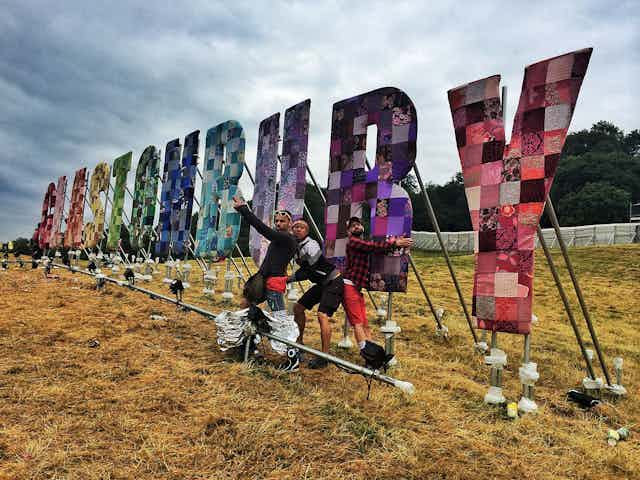With the gates of Glastonbury open, the British music festival season is now fully underway. Somerset’s Worthy Farm will welcome some 170,000 people to the pastures of Pilton over the coming weekend. And by the end of the summer there will have been hundreds of similar events on all sorts of scales and in all sorts of guises. These mini breaks from reality seem to be becoming ever more popular – but they’re no new thing. They actually draw upon a rich tradition of scores of people gathering to celebrate the changing of the season.
So: what makes a modern British festival? People are drawn to them by music, food, drink, dance and socialising. They come from some distance away, and travel – often with their own temporary homes – to set up cheek by jowl with friends and strangers. Festivals are about meeting different social groups, feasting on unusual foods and drinks, taking part in special activities, buying unusual items and hearing new sounds and ideas.
None of this are anything new. All these elements appear in ethnographic accounts of gatherings and can be traced back in time for thousands of years. Festival participants, like shamans before them, use the tried-and-tested five D’s to try to reach some other world: dancing, drumming, diet, drugs and dreaming. So perhaps future archaeologists sifting through the earth to look for clues that might tell them about Glastonbury won’t think very differently to how we do about the gatherings in our prehistoric past.

Indeed, many festivals draw explicit links to our folk and older traditions, with Druidic opening and closing ceremonies that incorporate ritualistic bonfire burning of effigies. Arthur Pendragon pops up at a fair few.
Glastonbury itself has a main stage, said to be situated on ley lines, that references the pyramids at Giza. It also has a stone circle, built in 1992, which channels megalithic traditions to provide a focal point for the Green Fields Sacred Space and a location for individuals looking to get lost in the moment. The circle has become famous for revellers taking laughing gas – althought this is something that organisers are trying to curb this year, citing its polluting qualities.
A long history
Mass gatherings in the UK started when the first farmers arrived. Huge monuments were built and tombs that sometimes housed hundreds of the dead. Take Stonehenge. Built a few thousand or so years later, large groups and teamwork were involved in its building and we’re in no doubt that many people gathered there whenever the stones and the sun aligned.
We don’t, however, have much evidence as to what occurred at these gatherings. Stonehenge is bewilderingly clean, inhabited only by the dead (cremated human remains have been found). There is little evidence of the activities of the living. Apart from the permanent stones, bank and ditches, these prehistoric party people appear to have followed the modern festival philosophy of “leave no trace”: at least at their main stage.

But luckily for us, just like at Glastonbury, these participants left the equivalent of their tents and their rubbish behind at their “campsite”. At Durrington Walls, about two miles from Stonehenge, there is evidence that thousands of people gathered here seasonally, probably to take part in activities associated with the solstices. Their food remains tell us that they feasted on pork and beef, that these gathering occurred mostly in midwinter and midsummer, and that the animals (and probably their owners) travelled from as far as Scotland.
Despite the abundant archaeological evidence at Durrington Walls it remains difficult to provide details on the social nature of ancient “festival” activities. Ethnography and analogy suggests that in a world with no other forms of mass communication, festivals were the best way to exchange information.
These gatherings would bind societies together and provide a forum for socialising, meeting new partners, reinforcing allegiances, exchanging gifts and telling stories, trading exotic goods, learning new skills and passing on traditions. We cannot prove, but feel fairly certain, that in common with most of humankind they probably danced to music, drank alcohol (there is early evidence for brewing) and dabbled with drugs.
Future festival archaeology
So, in a few thousand years, will the archaeology of today reveal the social complexities of modern British festivals? While there are some permanent structures that will leave traces, others, including the Glastonbury “great wall”, will leave few marks. A visit to Worthy Farm out of season reveals a only a couple of enduring elements: a number of memorials, the pyramidal cow shed, a bridge, the stone circle and a central signpost. As for the detritus of daily lives, the remarkable attention paid to removing and recycling the considerable quantities of human rubbish results in mostly pristine sites.

There are, however, likely to be clues in the ground. Recent excavations at Stonehenge have revealed evidence of activity at the free festivals of the 1970s and 1980s, with bundles of pennies, used as weights by drug dealers, as well as old drink cans recovered. No doubt the archaeologists of the future will wonder at nitrous oxide canisters that escaped litter pickers, buried near Glastonbury’s stone circle.
There is an enduring relationship between modern and ancient festivals then, from rituals, to partying, to litter control. The social complexities of contemporary festivals undoubtedly shed some light on our interpretation of the past – and, by taking part in these mass celebrations, we can renew our links to the past.
Today’s festival fields, visited out of season, hold the same resonances as some of our great archaeological gathering sites: empty spaces where once thousands of people came together to live their lives. The British festival has a long and noble tradition and even in a world with mass communication, nothing beats a bit of face-to-face social interaction. Go on, follow in your ancestors’ footsteps: eat, drink and be merry.

